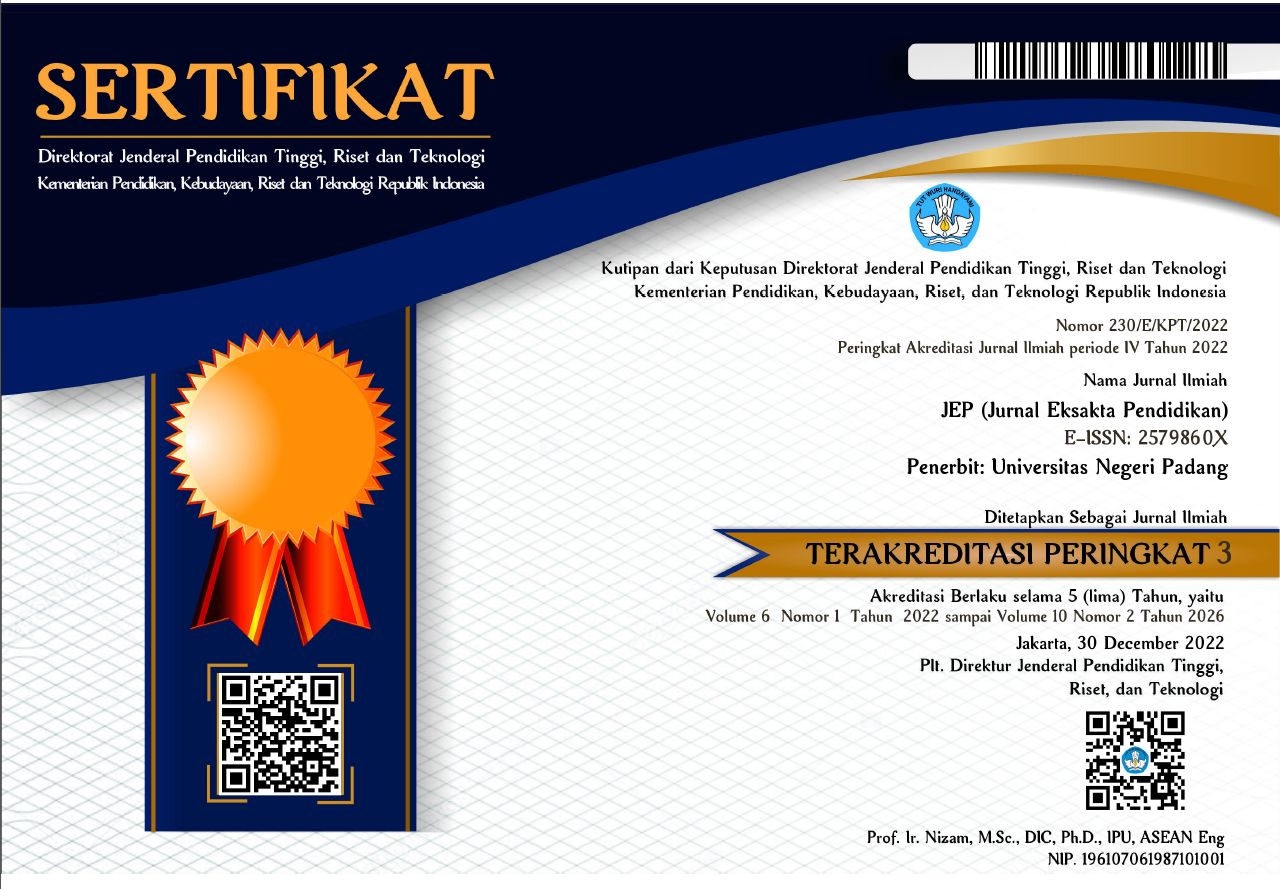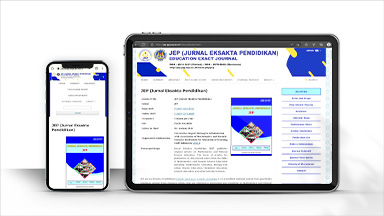Development of Android-based E-Modules on Molecular Shape Materials of VSEPR Theory
Abstract
The use of teaching materials in online learning during the Covid-19 pandemic results in a lack of students' understanding of the molecular shape material of the VSEPR theory leading to learning objectives not being achieved. So the researchers make an Android-based e-module as a teaching material as a solution so that students better understand the material of molecular shapes in online learning. This study aims to determine the feasibility of an android-based e-module on the molecular shape material of the VSEPR theory. This research used a research and development (R&D) method which is based on the ADDIE model. The android-based e-module on the molecular shape material of the VSEPR theory was validated by an expert or validator which included the feasibility of the material, language, and graphics. The results show that the android-based e-module developed is categorized as very feasible to use. This Feasibility is reviewed from the results of the validation of the feasibility of the material which obtain a validity score of 92.69% showing that the e-emodule made has fulfilled the Feasibility aspects including the suitability of the material and basic competence, the accuracy of the material, the updating of the material, and encouraging curiosity. Language Feasibility validation with a validity score of 92.69% shows the module made has fulfilled the Feasibility aspects of being straightforward, communicative, conformity with the development of students, and conformity with the correct rules of the Indonesian language. Graphic feasibility validation with a feasibility percentage of 91.66% with very decent criteria shows that the e-module has met the qualifications from the aspect of measurement, cover design, and cover body design. The feasibility research results obtained will be applied as a reference in the manufacturee-mode android based, so the e-modules that are suitable for use can be used in further research
Downloads
References
Agustina, E. (2015). Pengaruh Desain Sampul Buku Terhadap Minat Baca Siswa di Perpustakaan MAN Yogyakarta III. Skripsi Program Studi Ilmu Perpustakaan Fakultas Adab dan Ilmu Budaya Universitas Islam Negeri Sunan Kalijaga Yogyakarta.
Aksela, M. (2005). Supporting Meaningful Chemistry Learning and Higher-Order Thinking Through Computer-Assisted Inquiry: A Design Research Approach. Desertasi yang tidak dipublikasikan. Finlandia: University of Helsinki
APA: ejaan. (2016). Pada KBBI Daring. Diambil 26 Januari 2023, dari https://kbbi.kemdikbud.go.id/entri/ejaan.
Asrizal, A., Zan, A.M., Mardian, V., & Festiyed, F. (2022). The Impact of Static Fluid E-Module by Integrating STEM on Learning Outcomes of Students. Journal of Education Technology, 6(1), 110-116.
Branch, R, M (2009). Instructional design: the addie approach. New York: Springer.
Chorina, M. (2020). Pengembangan Suplemen Kimiapedia Berbasis Literasi Sains Materi Periodik Unsur Periode 1-5. Natural: Jurnal Ilmiah Pendidikan IPA. Vol. 7, No. 1.
Darmanella, D., & Komala, R. (2018). Validitas Pengembangan Modul Pembelajaran Biologi Berorientasi Mind Map dengan Variasi Tebak Kata untuk Peserta Didik Kelas VIII SMP. Jurnal Eksakta Pendidikan. Vol 2, No 2.
Daryanto. (2014). Pengembangan Perangkat Pembelajaran. Yogyakarta: PT Gava Media.
Firdan, A. (2011). Pengenalan Dasar android Programing. Depok: Biyarnara.
Gustin, V, S., Siregar, J, S., & Jubaedah, L . (2020). Kegunaan Media Pembelajaran Animasi Dalam Proses Belajar Mengajar Materi Tata Rias Pengantin Lampung Pada Prodi Tata Rias. Prosiding Seminar Nasional Pendidikan Antropologi (SENASPA), Vol. 1 Tahun 2020, Hal 154 - 160
Herawati, N, S. (2020). Pengembangan Modul Elektronik (E-Modul) Interaktif pada Mata Pelajaran Kimia Kelas XI IPA SMA. Jurnal At-Tadbir STAI Darul Kamal NW Kembang kerang. Volume : 4 No 1.
Hurrahman, M., Erlina., Melati, H, A., Enawaty, E., & Sartika, R, P. (2022). Pengembangan E-Modul Berbasis Multipel Representasi dengan Bantuan Teknologi Augmented Reality Untuk Pembelajaran Materi Bentuk Molekul. Jurnal Pendidikan Sains Indonesia. JPSI 10(1):89-114.
Irwan. (2017). Pengembangan Media Booklet Dalam Pembelajaran Ikatan Kimia Pada Mata Pelajaran Kimia Sekolah Menengah Atas. Artikel Penelitian Program Studi Magister Teknologi Pendidikan FKIP Untan Pontianak
Kiki. (2014). Pengembangan Multimedia Interaktif untuk Pembelajaran Bentuk Molekul di SMA. Jurnal Pendidikan Kimia Universitas Sriwijaya. 1(1), 59 – 65.
Lalu. (2018). Pengembangan E-Modul Interaktif Berbasis Android dan Nature of Science Pada Materi Ikatan Kimia dan Gaya Antar Molekul Untuk Menumbuhkan Literasi Sains Siswa. Hydrogen: Jurnal Kependidikan Kimia. Vol.6, No, 2 p-ISSN: 2338-6487. e-ISSN: 2656-3061 (pp.133-141).
Mamluah, S, K,. & Maulidi, A. (2021). Pembelajaran Jarak Jauh (PJJ) di Masa Pandemi Covid-19 Di Sekolah Dasar. Jurnal Basicedu Research & Learning in Elementary Education. Volume 5 Nomor 2 Tahun 2021 Halaman 869-877.
Maryani, Y. (2014). Seri Penyuluhan Bahasa Indonesia Ejaan. Jakarta : Badan Pengembangan dan Pembinaan Bahasa.
Mudjito. (2001). Pembinaan Minat Baca. Jakarta: Universitas Terbuka.
Permendikbud Nomor 24 Tahun 2016 Tentang Kompetensi Inti dan Kompetensi Dasar Pelajaran Pada Kurikulum 2013 Pada Pendidikan Dasar dan Pendidikan Menengah.
Randa, S., Fajriah, A., & Azhar, M. (2017). Pengembangan Modul Konsep Mol Berbasis Inkuiri Terstruktur dengan Penekanan pada Interkoneksi Tiga Level Representasi Kimia Untuk Kelas X SMA. Jurnal Eksakta Pendidikan. Vol 1, No 2.
Riduwan. (2015). Skala Pengukuran Variabel - Variabel Penelitian. Bandung: Alfabeta.
Salsabila, H, U., & Agustian, N. (2021). Peran Teknologi Pendidikan dalam Pembelajaran. Islamika : Jurnal Keislaman dan Ilmu Pendidikan Volume 3, Nomor 1, Januari 2021; 123-133.
Santoso, F. (2013). Pengembangan Media Interaktif Berbasis Komputer pada Pokok Bahasan Geometri Molekul di Kelas XI IPA SMAN 1 Sidoarjo. Unesa Journal of Chemical Education. Vol. 2, No. 2, pp. 188-195.
Sapto, H. (2009). Efektivitas pemanfaatan media audio – visual sebagai alternatif optimalisasi model pembelajaran. Jurnal Edukasi Elektro. Vol. 5, No. 1
Siregar, A, D., & Harahap, L, K. (2020). Pengembangan E-Modul Berbasis Project Based Learning Terintegrasi Media Komputasi Hyperchem pada Materi Bentuk Molekul. Jurnal Penelitian Pendidikan Sains. Vol 10, No 01.
Sugihastuti. (2007). Bahasa Laporan Penelitian. Yogyakarta: Pustaka Pelajar.
Sugiyono. (2013). Metode Penelitian Kualitatif, Kuantitatif, dan R&D. Bandung: Alfabeta CV.
Sumarni., & Suryani. (2018). Media Pembelajaran Inovatif dan Pengembangannya. Bandung: PT Remaja Rosdakarya.
Suryadie. (2014). Pengembangan Modul Elektronik IPA Terpadu Tipe Shared untuk Siswa Kelas VIII SMP/MTs. Yogyakarta: UIN Sunan Kali Jaga
Wegener , D. R. (2006). Training Library Patrons the Addie Way. Oxford: Chandos Publishing.
Copyright (c) 2023 Wandi Wandi, Eny Enawaty, Rini Muharini, Rodi Putra Sartika

This work is licensed under a Creative Commons Attribution 4.0 International License.

This work is licensed under a Creative Commons Attribution 4.0 International License.




_(2579-860X).png)
_(2614-1221)1.png)




